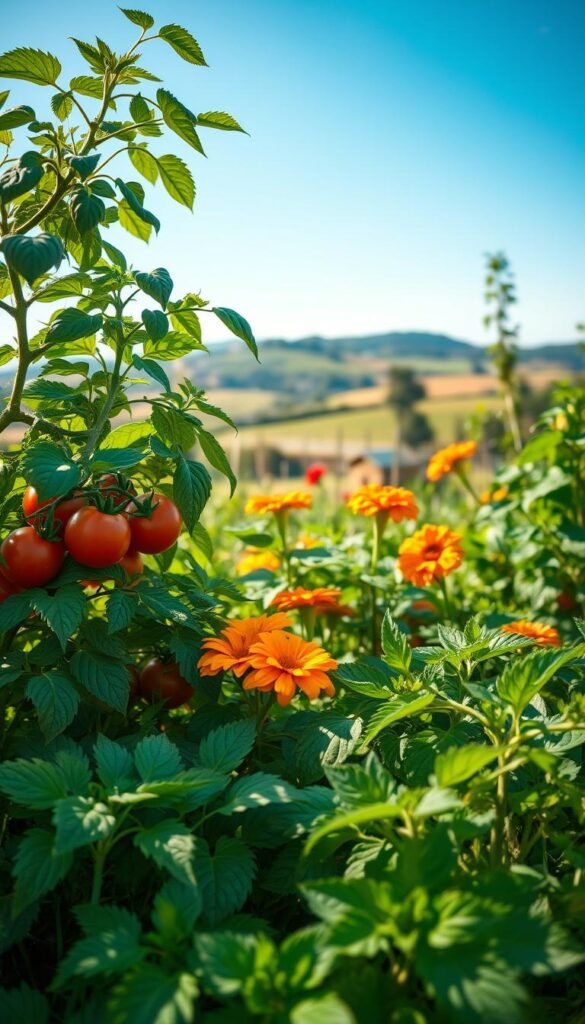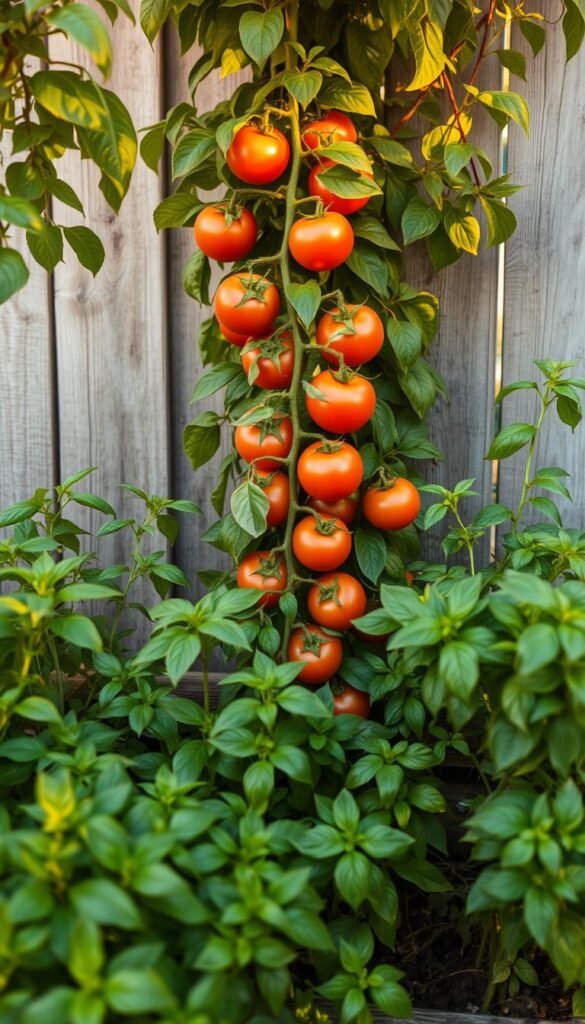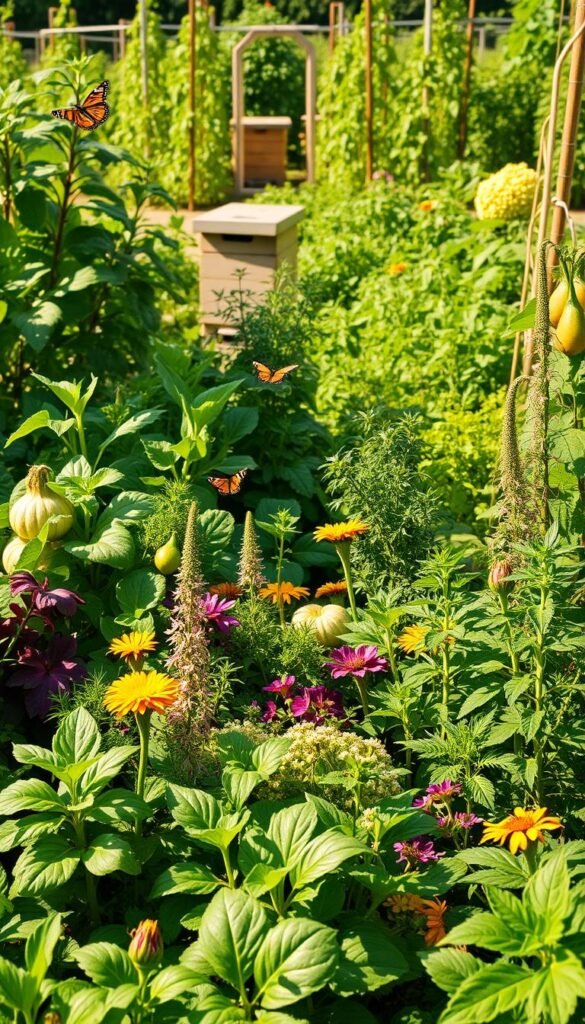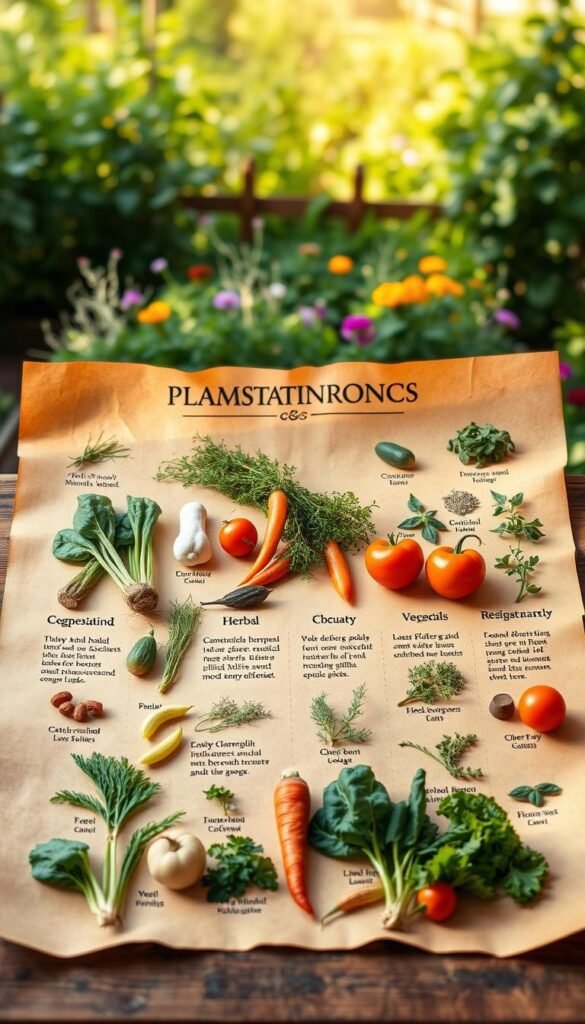Ever noticed how some crops thrive when grown together? This isn’t luck—it’s strategic pairing. Just like ingredients in a recipe, certain species help each other flourish.
The USDA-backed Three Sisters method proves this works. Corn, beans, and squash support one another naturally. Corn provides structure, beans add nitrogen, and squash shades the soil.
These partnerships offer real benefits. They deter pests without chemicals, improve pollination, and maximize space. Some combinations even enhance taste—basil near tomatoes creates sweeter fruit.
Ready to transform your garden? Discover how simple pairings can yield healthier, more productive harvests.
What Is Companion Planting? (And Why You Should Try It)

Nature has its own way of creating perfect partnerships—some plants just grow better together. This method, called companion planting, pairs species that help each other thrive. From pest control to richer soil, the benefits are backed by science and centuries of tradition.
The Science Behind Plant Friendships
Plants communicate through chemicals—a process called allelopathy. For example, marigolds release root secretions that repel harmful nematodes. This invisible teamwork keeps gardens healthy without pesticides.
Legumes like beans take it further. They host rhizobia bacteria in their roots, which convert air nitrogen into a form plants can use. Research from the Franklin Park Conservatory shows this enriches the soil naturally.
How Indigenous Practices Shaped Modern Methods
Native American tribes perfected the Three Sisters technique—corn, beans, and squash grown together. Corn stalks support bean vines, beans add nitrogen, and squash leaves shade the soil. This ancient wisdom is now validated by USDA studies.
Modern gardens adapt these principles. Sunflowers, for instance, act as trellises for cucumbers in small spaces. As Rutgers University confirms, biodiversity beats monoculture by reducing pests and improving yields.
- Natural pest control: Marigolds deter beetles; basil repels flies.
- Soil health: Beans and clover fix nitrogen, reducing fertilizer needs.
- Space efficiency: Vertical growers (like pole beans) save ground space.
Ready to experiment? Start with proven pairs like tomatoes and basil—they’re beginner-friendly and packed with perks.
Companion Gardening: Plant Pairings That Work Like Magic

Strategic pairings unlock hidden potential in your garden beds. These time-tested duos tackle pests, boost yields, and even improve flavor—all naturally.
Tomatoes + Basil: The Dynamic Duo
Texas A&M research shows basil reduces thrips on tomatoes by 63%. Its scent masks the plants’ aroma, confusing hornworm moths.
Bonus? Harvest both for homemade pesto. Just snip fresh basil as tomatoes ripen.
The Three Sisters: Corn, Beans, and Squash
This Native American trio outproduces monocrops by 20%. Corn stalks support beans, which fix nitrogen. Squash leaves shade weeds.
Pro tip: Use a 4’x4′ plot minimum. Overcrowding stunts growth.
Garlic: The Ultimate Pest Bodyguard
Kentucky studies found garlic sprays deter 89% of aphids. Plant cloves every fourth row near potatoes or roses for protection.
For square-foot gardens, tuck garlic between compact crops like lettuce.
7 Proven Benefits of Companion Planting

Your garden can work smarter, not harder, with the right plant partnerships. These benefits companion planting offers go beyond saving space—they create a thriving ecosystem where each species supports others.
Natural Pest Control Without Chemicals
Iowa State researchers found thyme mulch reduces armyworm eggs by 74%. Plants like marigolds and nasturtiums act as bodyguards—marigolds repel beetles, while nasturtiums lure aphids away from crops.
This trap cropping strategy protects veggies without sprays. Just remember: pesticide overspray can harm beneficial insects like ladybugs.
Attracting Pollinators for Better Yields
Borage flowers near tomatoes boost pollination rates by 33%, per agricultural studies. Bright blooms like zinnias and ageratum are pollinator magnets, ensuring fruits develop fully.
For a double win, try poached egg plant—its nectar draws bees while its roots aerate soil.
Soil Enrichment and Nutrient Sharing
Buckwheat cover crops add 28% more phosphorus to soil, and comfrey pulls potassium from deep underground. Legumes like beans fix nitrogen, reducing fertilizer needs.
These nutrients circulate naturally, creating richer earth season after season.
- Higher yields: Companion plots produce 19% more vegetables.
- Less work: Healthy soil means fewer amendments.
- Eco-friendly: No synthetic chemicals needed.
Ready to try? Start with proven pairs from The Old Farmer’s for guaranteed success.
Flowers That Pull Double Duty in Your Garden
Bright blooms aren’t just pretty—they’re garden bodyguards. These flowers repel pests, lure pollinators, and even enrich your soil. Here’s how to harness their hidden superpowers.
Marigolds: The Pest-Repelling Powerhouse
French marigolds slash root-knot nematodes by 92% when tilled into soil. Their roots release alpha-terthienyl, a natural toxin.
“Plant one marigold per 10 sq ft for optimal pest control.”
Heads up: Avoid cramming them in small pots—their allelopathic chemicals can stunt nearby herbs.
Nasturtiums: Trap Crops for Hungry Insects
These vibrant blossoms lure 78% of cabbage white butterflies away from brassicas. Plant a ‘sacrificial ring’ around broccoli or kale.
- Best variety: ‘Empress of India’—compact with pest-confusing red blooms.
- Pro tip: Let aphids feast on nasturtiums to spare your veggies.
Borage: A Bee Magnet with Hidden Perks
Borage flowers feed bees day and night. Their leaves brew into potassium-rich tea—just steep fresh leaves in hot water.
| Flower | Key Benefit | Best For |
|---|---|---|
| Lemon Gem Marigolds | Nematode control | Tomato beds |
| Nasturtiums | Trap cropping | Brassica gardens |
| Borage | 24/7 pollinator food | Berry patches |
Pair these multitaskers with veggies for a garden that’s as productive as it is beautiful.
Vegetable Combinations You Need to Know

Your veggie patch can become a powerhouse with the right plant alliances. These vegetable teams defend against pests, share nutrients, and maximize space efficiently.
Brassicas and Their Protective Allies
Cabbage family plants need extra protection from pests. Try this brassicas guild for natural defense:
- Cabbage or kale as the centerpiece
- Celery to repel white butterflies
- Onions deter root maggots
- Nasturtiums as aphid traps
UK trials show this combo reduces pest damage by 41%. Pro tip: Avoid planting strawberries nearby—they stunt brassica growth.
Cucumbers and Their Perfect Partners
Cucumbers thrive with vertical support and pest control. Train vines up corn stalks while planting dill nearby—Rutgers found this increases yields by 19%.
Radishes make great intercrops too. They reduce flea beetles on eggplants by 67%, protecting your entire vine section.
Root Vegetables That Thrive Together
Pair shallow and deep-rooted varieties for space efficiency:
- Carrots (12″ roots) + radishes (6″ roots)
- Beans + follow with nitrogen-loving corn
- Lettuce as quick filler between slow growers
Carrot and leek duos confuse pests with their scents. This simple trick cuts damage nearly in half.
Herbs That Elevate Your Garden’s Health

Herbs aren’t just kitchen staples—they’re secret weapons for a thriving garden. Their fragrant leaves repel pests, attract allies, and even improve soil. Here’s how to harness their hidden superpowers.
Dill: The Ladybug Whisperer
Michigan State research found dill attracts 23% more ladybugs per square foot. These beneficial insects devour aphids and mites.
Try a “ladybug lane”: Plant dill every 15 feet along crop rows. The lacy flowers also lure pollinators for better tomato yields.
Sage and Rosemary: Fragrant Defenders
Canadian studies show rosemary oil repels 81% of carrot rust flies. Plant a hedge around carrot beds for protection.
“Sage’s strong scent confuses cabbage moths, reducing damage by half.”
Dry sage bundles for winter use—hang them in a cool, dark spot.
Mint (But Keep It Contained!)
Mint slashes aphid colonies by 94%—but it spreads aggressively. Use submerged 5-gallon buckets to control roots.
- Preservation tip: Freeze mint leaves in ice cubes for summer drinks.
- Warning: Never plant mint near veggies—it overwhelms their roots.
| Herb | Key Benefit | Best Pairings |
|---|---|---|
| Dill | Attracts ladybugs | Tomatoes, lettuce |
| Rosemary | Repels carrot flies | Carrots, beans |
| Mint | Deters aphids | Brassicas (in pots) |
Common Companion Planting Mistakes to Avoid
Even the best-intentioned gardeners can stumble with plant partnerships. Some combinations compete for resources or attract pests instead of repelling them. Here’s how to sidestep common errors and keep your garden thriving.
Plants That Compete Instead of Cooperate
Not all species play nice. Washington State research found fennel inhibits 53% of nearby vegetable growth. Other problematic pairs:
- Tomatoes + cucumbers: Compete for calcium, increasing blossom end rot.
- Onions + peas: Onions stunt pea vine growth.
- Potatoes + tomatoes: Both attract Colorado potato beetles.
“Fennel’s allelopathic chemicals make it a poor neighbor for most veggies.”
Overcrowding: When Good Intentions Go Wrong
Too many plants in one space fight for nutrients and light. Follow these spacing guidelines for popular pairs:
| Pair | Minimum Spacing |
|---|---|
| Tomatoes + Basil | 12–18 inches |
| Carrots + Radishes | 6 inches |
| Corn + Beans | 4 feet between rows |
Fix overcrowded beds: Thin seedlings early and prune aggressive growers like mint.
Ignoring Sun and Water Needs
68% of failed plots have mismatched hydration. Group plants by needs (hydrozoning):
- Drought-tolerant: Rosemary, lavender (full sun, dry soil).
- Thirsty crops: Lettuce, celery (partial shade, moist soil).
Yellow leaves? Check for root competition or waterlogged soil.
Getting Started with Your Companion Garden
Ready to turn your backyard into a thriving ecosystem? Start small—a 4×4 ft plot with three proven pairs saves 23% effort. The beginner trio of tomatoes, basil, and marigolds offers pest control and sweeter yields.
Grab essentials like a soil test kit and planting grid. Track results with a companion journal to see what works. Tools like the Almanac Garden Planner cut errors by 41%.
Share wins with local clubs. Companion planting thrives on shared knowledge. Your first season’s growth will reveal the benefits of teamwork—above and below the soil.





